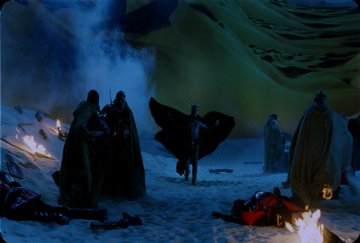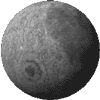Sometimes it's not possible - or necessary - to shoot the actor in front of a green or blue screen to create a composite. For this article I'l be explaining how I composited a Background Plate and a Foreground Plate which were shot from the same locked down camera and the same set. Just two different actions and actors.
When they filmed Alec Newman ("Paul") walking alone through the set, the speed of the film was slowed down for reasons I'll explain later. Then the other actors in the scene - minus Alec - were filmed but at the normal speed. The idea was to composite PAUL into the crowd. He was moving at a different speed to show the "weirding way" so he had to be filmed separately. Don't worry if this sounds confusing. I'll have the rest of the page to confuse you even more...
Making the Visable Invisable
|
This is the Background Plate. It was shot on a set made of sand (which will be a problem later on so take note). On the set wall you can see the infamous "TransLite" which is basically a computer generated images printed on a really big plastic sheet and tacked up on the wall. It has a greenish tint to it while the sand has a bluish light on it. Why this is so I cannot say. A blind person can see they look completely separate. But I digress.... What you should note is that there is fire flickering and smoke blowing during the footage which runs, as I recall, some 200 to 300 frames All of which alters the color of the animation as it runs. |

|
|
This is the ForeGround Plate. This is the footage that was shot at a different speed from normal. Notice the large fan toward the right side of the frame. They were blowing Alec's cape so it looked, well, cool. For practical reasons, it's easier to see that PAUL is doing his "weirding" thing if his cape as well as his walk is S..L..O..W.. Now, notice, boys and girls, that there is no smoke and no fire. This is important because it changes the color temperature of the entire frame. And every frame. Trust me. |
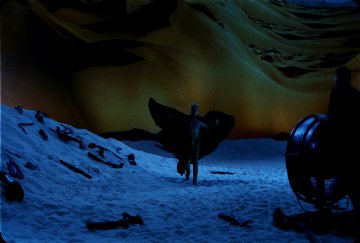
|
So What Did They Want Me to DO?
|
I'm not trying to be coy here but when this scene was given to me I was told it would be a simple composite and all I'd probably have to do is make a very crude matte around PAUL, blah, blah blah. And I'm sure all involved really thought that. On first look, it seems simple enough. However - I think a blind person looking at this test can see that when one composites the background with the foreground that they have entirely different color temperatures (the Foreground image has a more orange Translite while the Background is greener. And the sand in the Foreground is lit by a light and therefore a much brighter blue). Both are different enough from each other to require a tighter matte. And while no one had a panic attack, there was some general concern. (When is there NOT???) |
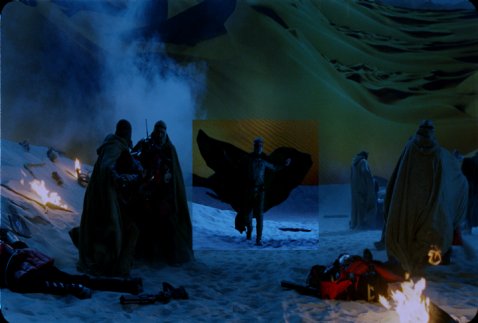
|
Designing a Matte
|
I used AfterEffects spline matte to make two mattes. The first matte - is the area indicated by the red line - which is is PAUL and his flying cape. That's so I could feather the edges of this matte. While you can naturally keyframe everything in AfterEffects, the feathering effects the entire matte. So if you need a different feathering in a certain area, you must.... Make a new matte! Which is what I had to do around PAUL's feet. This is indicated by the yellow area. (I'm taking some licence here. Even though I'm talking about two mattes and that means two plates in the composite process, I'm showing them in the same image shown to the right. Just use your imagination). I had to feather alot more in this part of the footage because as Alec walks his feet are kicking up sand. And this has to somehow match the sand in the Background which had NOT been walked on by Paul. Also, don't forget that the color in each plate is different and changes every other frame or so. This was a very tricky bit of spline-making as I had to be careful of the shape - which was basically undefined (your basic "sand around his feet - Duh!) and manipulating the feathering just in this area. |
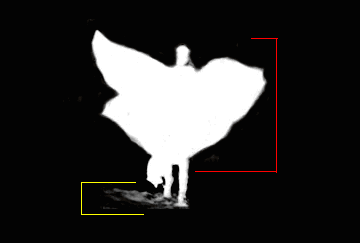
|
What's Your Final Answer?
The contents may not be reproduced in whole or part, in any form, without prior written consent from cecilia. You have been warned ;)
Need help with this topic? Email Me
 DUNE: My Wonderful Work! by cecilia
DUNE: My Wonderful Work! by cecilia
